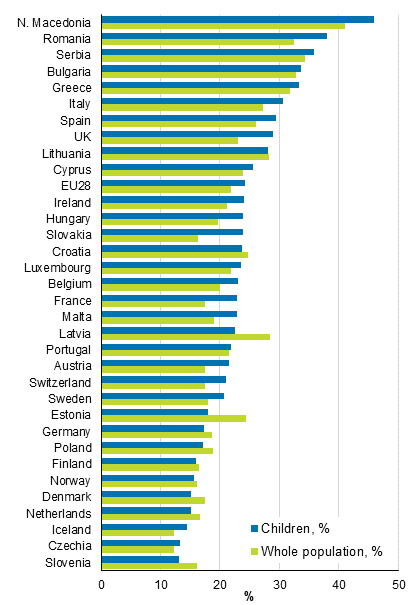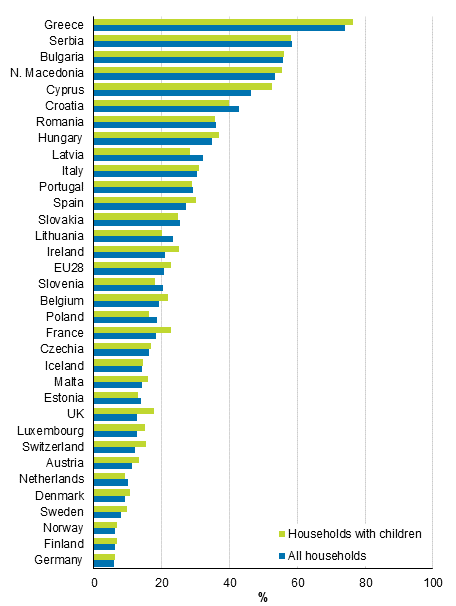Published: 5 May 2020
Nearly every fourth child in the EU is at risk of poverty or social exclusion
In all, 24.2 per cent of children, or nearly 23 million, were at risk of poverty or social exclusion in the EU countries in 2017. At that time, 16 per cent, or around 172,000 children aged under 18, were at risk in Finland. Children's risk is higher than that of the whole population on the EU level, as 21.8 per cent of the citizens of the 28 EU countries were at risk of poverty or social exclusion. In Finland, the risk of children is slightly lower than the general risk of the population, as the risk of the whole population was 16.5 per cent in 2017. These data derive from the European Union Statistics on Income and Living Conditions, where Finland’s data are based on Statistics Finland’s statistics on living conditions.
Share of whole population and children at risk of poverty or social exclusion 2017, %. Countries are sorted by children’s risk.

Source, EU-SILC, Eurostat. Finland’s data are based on Statistics Finland’s statistics on living conditions. Data concerning Iceland refer to 2015.
Of the EU countries, over 30 per cent of the household population were at risk of poverty or social exclusion in Romania, Bulgaria and Greece in 2017. In these countries, similarly as in Italy, over 30 per cent of the child population were at risk of poverty or social exclusion. The risk of children is lowest in Slovenia, the Czech Republic, Iceland and the Netherlands. The share of children at risk in Finland is 16 per cent, which is the fifth lowest in the EU.
Living in a low income household is the most common reason for the risk of poverty or social exclusion in all EU countries. The more common the risk of poverty or social exclusion is in the country, the more common is also households’ low work intensity and severe material deprivation. In addition, in countries with a high risk of poverty or social exclusion there is a larger group of those for whom the risk materialises in more than one dimension at the same time.
Being at risk of poverty or social exclusion means that the person is living in a low income household, a household with low work intensity or a household that experiences severe material deprivation. One of these risks materialising means that the person is at risk of poverty or social exclusion, but the risks can also be simultaneous.
In Eurostat's database data on the risk of poverty or social exclusion are published according to the data collection year, but the statistics on living conditions use the income earning year, which is the year preceding the data collection year. The data on risk of poverty or social exclusion published by Eurostat are based on the same sample data as Statistics Finland's statistics on living conditions. There is a small difference in the data on risk of poverty or social exclusion due to the difference in the income concept used in the calculation of persons living in low income households. More information about the risk of poverty or social exclusion in different countries is available in the review of this publication (in Finnish).
Every fifth household in the EU experienced difficulties in making ends meet in 2018
In the EU 20.7 per cent of all households had difficulties or great difficulties in making ends meet in 2018. Of households with children, 22.6 per cent experienced difficulties in making ends meet. Difficulties in making ends meet both among all households and households with children are most common in Greece, where more than three out of four households reported experiencing difficulties in making ends meet. In Finland, households reported the second least difficulties in making ends meet in the EU: 6.1 per cent of all households and 6.7 per cent of households with children said that the household has difficulties or great difficulties in making ends meet.
Share of all households and households with children having difficulties or great difficulties in making ends meet in 2018.

Source, EU-SILC, Eurostat. Finland’s data are based on Statistics Finland’s statistics on living conditions. Data concerning Iceland refer to 2016.
In this connection, households with children refer to households that have children aged under 18, but also to such households where adult children aged under 24 are students, unemployed or other non-employed persons (dependent children). The data are collected in all countries by asking how easy or difficult it is for them to make ends meet. The response alternatives are with great difficulty, with difficulty, with some difficulty, fairly easily, easily and very easily.
Source: Statistics on living conditions 2019, Statistics Finland
Inquiries: Kaisa-Mari Okkonen 029 551 3408, Marie Reijo 029 551 2547
Director in charge: Jari Tarkoma
- Tables
-
Tables in databases
Pick the data you need into tables, view the data as graphs, or download the data for your use.
Updated 05.05.2020
Official Statistics of Finland (OSF):
Statistics on living conditions [e-publication].
02 2019. Helsinki: Statistics Finland [referred: 19.12.2025].
Access method: http://stat.fi/til/eot/2019/02/eot_2019_02_2020-05-05_tie_001_en.html

